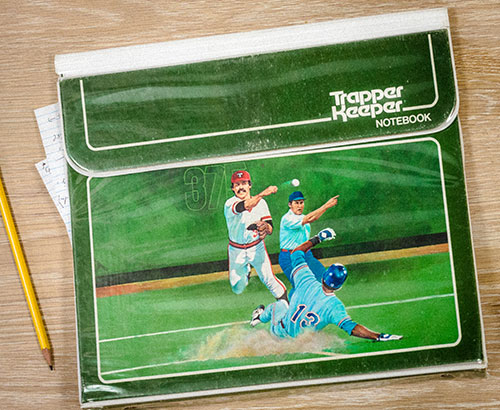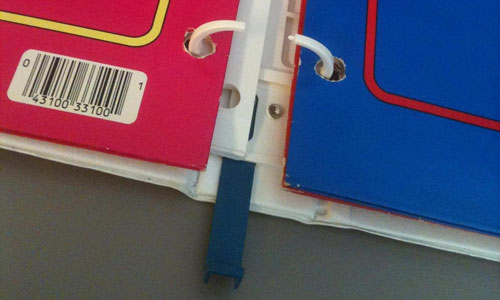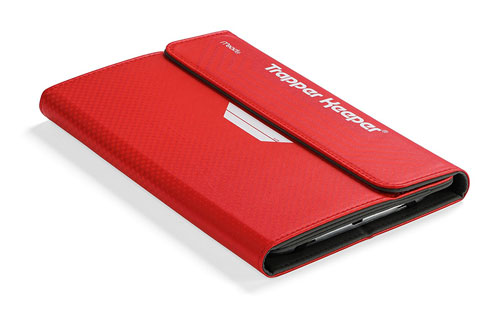Trapper Keeper Contraband
The Trapper Keeper is a beacon of nostalgia, but generic branding and school rules have pushed it off to the side. Good luck finding a new one.
Editor’s note: With the idea of treating my work as something of a living document, I sometimes update old Tedium issues in an effort to keep them up to date. When I was updating this one, though, I noticed something weird, and as a result, I wrote a much bigger update than usual. Read on, pals.
“You just got like a Trapper Keeper full of appointments, right?”
— A line from the immortal Wet Hot American Summer, mocking and admiring the binder all at once. (Free idea: A Wet Hot American Summer-branded Trapper Keeper.) It became a kitsch icon, but the road to its success was unusual, in that its manufacturer, Mead, didn’t expect it to be nearly as successful as it became. According to a 2013 Mental Floss article that’s something of a Bible on the subject, the Trapper Keeper was responsible for more than $100 million in Mead’s sales and moved 75 million units. For such a cool device, it came about in a reliably nerdy way—thanks to a bunch of market research.

Why Trapper Keepers Drive Teachers &!&@*!% Crazy
The Trapper Keeper of yore did something really interesting for an organizer: it was hip. Years before Nike proved that cool kids love inanimate objects that could be used as status symbols, Mead’s binder was already there, with an easy way to express one’s personality and style in the classroom.
But there was just one problem: They frustrated teachers for a wide variety of reasons. Among the problems? Their size, the fact that the organizers once used velcro, and the fact that there were multiplication tables inside of them. As a result, schools would ban these beacons of efficiency because said efficiency benefits could not be trusted in the hands of 11-year-olds.
It’s a situation that, to this day, confuses the heck out of some education professionals.
“Yes, schools are stricter about certain things than they used to be, but this one threw me,” wrote Inside Higher Ed blogger (and community college dean) Matt Reed. “First peanut butter, now this. There had to be a reason.”
Perhaps the best explanation for the ban comes from a 2001 Washington Post article, which points out that many teachers find the devices’ large size and relative complexity a deterrent when it comes to getting stuff done in the classroom.
“You ask a student to take out a worksheet, and by the time they open all the sections out and find it, the Trapper Keeper has reached over to another person’s desk,” argued fourth-grade teacher Lucinda Mann, who took particular issue with the way that the binders flapped out on desks.
The other argument that the article highlighted was that teachers believed that the devices failed at their primary task—organizing information.
“The kids with Trapper Keepers tend to throw the papers in and don’t organize. They can’t find anything,” explained sixth-grade English teacher Janice Kopp.

The issue might not even be the binders themselves, but the facilities of the school. A random search of actual school-supply documents emphasizes that the issue may be one of physical space.
Park Elementary in Kearney, Nebraska, is just one example of this stance in action. In bold letters at the top of their recommended school supplies lists, they state, “NO TRAPPER KEEPERS or BOOKBAGS ON WHEELS (they just don’t fit in lockers).”
A search of similar documents around the country suggests this stance is not unique, especially at elementary schools and some middle schools.
So, what’s the big reason for this?
As it turns out, lockers are expensive. Desks aren’t cheap, either. Making room for all those students and all their school supplies? That stuff costs money. So it doesn’t matter if the rules sound arbitrary and stupid and obsessed with order over taste—ultimately, kids and their retro-minded parents have to live with the fact that many schools are not going to let kids have Trapper Keepers.
Lockers and desks are small and you just have to deal with it, Chappie.
$80+
The price range that a higher-end Trapper Keeper goes for on eBay these days, as a result of a growing cultural interest in the binders. The Outline noted earlier this year that rare variations of the Trapper Keeper often sell for above $100 and sometimes as high as $250—often with designs inspired by Lisa Frank or with artistic designs that seem more modern now than they did in the late ’80s. Also worth looking for: Sonic the Hedgehog Trapper Keepers. Sonic the Hedgehog was apparently a pro at school supplies.

A Trapper Keeper iPad case. It’s cool, but not the same.
Did the Trapper Keeper get discontinued? A brief investigation
As I was doing research on the state of the Trapper Keeper in 2018, I noticed a problem which made me wonder if the contraband status of the colorful folder organizer finally caught up with it.
I searched for some models for purchase on Amazon and found nothing but folders and notebooks—no binders. Target, same deal. Walmart, ditto.
And then I went to the Mead site, doing a search for Trapper Keepers, and found myself a bit stunned. The organizer that had built its brand name more than anything else was nowhere to be seen. Sure, there were notebooks and folders, but nothing to trap them.
There are no binders to be found, unless you’re in the market for an iPad case that looks like a vintage Trapper Keeper design.
This is bizarre to consider. The three-ring binders were the reason kids cared. But Mead appears to have put most of its binder energy into its Five Star brand.
So, what the heck happened? Is the Trapper Keeper dead? Upon this discovery, I did what a good journalist does: I reached out to the source.
First, I tried calling customer service for Mead’s parent company, ACCO Brands. The person on the other line, when I asked them about the lack of Trapper Keeper binders available for sale from major retailers, informed me that if it’s not on the website, it’s discontinued. I felt my heart slowly sinking as I learned this information. Did the Chromebook and the iPad finally murder it? But that hypothesis didn’t exactly make sense, because Mead’s own Five Star binders were plentiful, and easy to find on sites like Amazon.
I wondered if something deeper is at play—that Mental Floss piece on how awesome the Trapper Keeper is isn’t that old, is it? So I reached out up the ACCO food chain in hopes of figuring out why it was so hard to find this year.
Richard Nelson, ACCO Brands’ Vice President of Corporate Communications, did me a solid and researched the issue for me, helping me figure out exactly what happened. Long story short: The Trapper Keeper is not dead, and is still being produced, but it’s not exactly easy to find this school year.
“You can still find it in retail outlets, but you won’t find it at any of the major office products channels, for example,” he says.
Usually, you might be able to find a product like this on Amazon, but the website is sold out at the moment and has not ordered any new units as of yet. So, where do you go?
Nelson says that the company, which outsources the production of the famed binders, often doesn’t have a close eye on where exactly wholesale products like the Trapper Keeper end up, but he says that, most likely, if you want to find some fresh ones, your best bet might actually be an independent stationery store, rather than a large chain—which means that, if you really want one right now, you’re going to either have to do your homework (heh) or take a close look on eBay.
“There’s enough of a demand that we keep making them and shipping them,” Nelson added.
But why aren’t they in? Did the Trapper brand falter? Nelson hinted that at least part of the problem might be the somewhat generic state of the name “Trapper Keeper” in 2018. When chatting, we compared the brand to Kleenex more than once.
“A lot of times now, when you go into a retail outlet and say, ‘I’m looking for a Trapper Keeper,’ you get guided to another three-ring zipper binder,” he explained, adding that partly as a result of this that the company has put its focus on the Five Star brand, which fits the three-ring zipper binder bill.
Even considering all that, Nelson emphasized that there remains an interest in Trapper Keepers in general, something that the company has often tapped into considering the brand’s iconic appeal, but this year at least, it’s taking something of a break, though the company will keep a close eye on its brand mix.
(The closest you’ll get is the iPad case, which the company has found to be a consistent seller since its release a few years ago.)
$1.5B
The amount Mead sold LexisNexis for in 1994. (It owned the research service it owned through its Mead Data Central subsidiary.) Here’s a crazy thing to think about: The company that created the organizer essentially helped launch one of the earliest online research services, which means they have a prominent role in the creation of the internet as we know it. Perhaps as a nod to its budding technology business, one of the Trapper Keeper’s predecessors in the 1970s was called the Mead Data Center, and it had nothing to do with databases.
These days, the modern equivalent of the Trapper Keeper may in fact be the tablet and the smartphone. These devices can feasibly organize millions more things than a Trapper Keeper ever could.
And just like the Trapper Keeper, schools and teachers love banning these things, because they think students will get distracted. Don’t believe me? One Boston-area high school recently went to the trouble setting up a system to put students’ cell phones in lockable bags during the school day, preventing them from being used during the school day at all. They’re taking a technology that’s best known for being used at Jack White concerts and putting it in schools.
(Perhaps it’s for this reason that ACCO’s Richard Nelson made a point of emphasizing that technology was not a reason for the brand taking a backseat.)
In the United Kingdom, many secondary schools are putting in place strict bans on cell phones in schools, a level of scrutiny that not even the Trapper Keeper faced during its heyday. UK Culture Secretary Matt Hancock spoke in tough terms in favor of such bans.
“Technology makes being a parent much harder. And schools have a big role too,” Hancock said, according to The Guardian. “I enthusiastically support using technology for teaching. But we also need to teach children how to stay safe with technology. Why do young children need phones in schools?”
Now, there’s some research to back this line of thinking up, but as a former kid who gained a lot from technology, I wonder if this issue goes both ways.
What if the problem here is less an issue of students being annoying or distracted and more about schools failing to engage them in a way that speaks their language? What if all those years ago, teachers embraced Trapper Keepers as useful tools that taught students important lessons about organization—a problem that, along with mathematics, science, and spelling, is something applicable to everyday life as an adult?
And what if teachers found ways to embrace smartphones as an educational tool, rather than just another annoyance? Or is that just crazy talk?
The smartphone likely won’t recede from the conversation anytime soon, like the Trapper Keeper has. But one must wonder what might happen if there was more of an embrace of stuff that kids bring in from outside the classroom.
Heck, it could even be an opportunity.
:format(jpeg)/2018/01/wbyuyiqtwvg3oswuyhw4--1-.gif)
/2018/01/wbyuyiqtwvg3oswuyhw4--1-.gif)

/uploads/ernie_crop.jpg)